The amount of junk in space is rising exponentially, with continuous collisions between abandoned equipment, spent rockets and other debris creating ever growing clouds of dangerous fragments, an influential report warned on Thursday.
The report, commissioned by Nasa, says the quantity of hazardous material circling the Earth has reached a "tipping point" and poses a real and increasing danger to satellites and the International Space Station.
It suggests developing a clean-up strategy, which could include catching debris with nets, magnets or giant umbrellas.
The US National Research Council was asked to review the space agency's meteoroid and orbital debris programmes last April following a request from the White House. Meteoroids are particles or larger lumps of rock in the solar system.
"The current space environment is growing increasingly hazardous to spacecraft and astronauts," said Donald Kessler, chair of the committee responsible for the report and a retired head of Nasa's orbital debris programme.
"Nasa needs to determine the best path forward for tackling the multifaceted problems caused by meteoroids and orbital debris that put human and robotic space operations at risk."
While the report, Limiting future collision risk to spacecraft, found Nasa had used available resources wisely, the authors raised concerns that the agency's programmes had no overall management or
budget and that most programmes were run by one person, making them vulnerable to staff changes.
Objects in space ranging from the huge upper stages of Russian rockets to tiny particles of liquid coolant are tracked by ground based radars operated by Nasa and other space agencies. About half a million fragments and objects larger than a centimetre are in low orbit around Earth. There are tens of millions of particles larger than a millimetre.
Comment: What NASA won't tell you is that these are the result of exponentially increasing quantities of comet debris in our immediate space environment.
Even minuscule specks of debris can cause serious damage to spacecraft and satellites because of the immense speeds at which they travel.
"The average impact velocity is 10km per second," Kessler told the Guardian. "And at 2km per second, the energy of the collision is equivalent to the particle's mass in TNT."
The potential threat from space debris became more pressing after China destroyed an orbiting weather satellite with a missile in 2007 as part of an anti-satellite test, and two satellites collided over Siberia in 2009.
These events more than doubled the amount of catalogued fragmentation debris in space, which had remained almost constant for the previous 20 years.
The report adds that Nasa may have to launch operations to remove space junk from orbit, or find other ways to reduce the dangers posed by debris.
Since the Nasa space shuttle was retired, there are no tried and tested means to remove defunct satellites and other space junk from orbit.
Several companies and agencies are exploring ways to clean up the space environment, with techniques that range from capturing the junk in lightweight nets to launching probes that latch on to debris and steer it into the atmosphere, where it will burn up.
Any programme aimed at removing space junk is likely to face serious legal hurdles, because current principles restrict countries to salvaging only their own objects. Nasa estimates that about 30% of space junk can be attributed to the United States.
In anticipation of future clean-up operations, 12 countries, including the UK, set up the Inter-Agency Space Debris Co-ordination Committee in 1993 to oversee the programme.
"The cold war is over, but the acute sensitivity regarding satellite technology remains," said George Gleghorn, the report's co-author and chief engineer for the TRW Space and Technology Group.
Comment: The Cold War is over, so the Powers That Be came up with the War on Terror and manmade global warming to distract us from waking up to the fact that Something Wicked This Way Comes.
Although Nasa had identified the need for removing debris, the agency and US government had not fully examined the economic, technological, political and legal considerations, the report added.
"The longer you wait to do this the more expensive it's going to be. Given the economy, we'll probably end up putting it off, but that's really not very wise. This scenario of increasing space debris will play out even if we don't put anything else in orbit," Kessler said.
Satellite and spacecraft manufacturers routinely build additional shields to protect against debris strikes, but there is a trade-off between safety and weight.
The International Space Station (ISS) has shields designed to withstand strikes from centimetre-sized objects, but satellites are less well protected.
Mission controllers can alter the orbits of the ISS and some satellites to avoid collisions, but this is not always effective.
In 2009, satellite operators might have been able to prevent the satellite collision over Siberia, but the defunct Russian Cosmos satellite involved was ranked 16th on a list of objects the US Iridium satellite was most likely to strike.
"Any avoidance move would have been to avoid something else," Kessler said.
As many readers already know, Comet Elenin has begun the irreversible process of breaking up. We spoke earlier about the probablility of such an outcome, but I considered it less than 50%. On the graph at left you can see a selection of ten comets that approach the Sun closer than 0.5 a.u. The red line shows the boundary, to the left of which, derived from J. Bortle's formula, is the safe zone, but to the right is the zone of disintegration. The yellow color shows Comet Elenin, with absolute magnitude obtained by visual observations, and the blue is from JPL-NASA data. As we see, Bortle's formula, all-in-all, doesn't work too badly. Although there is a bright exception - the green triangle belongs to the unique comet 96P/Machholtz, about which I will speak next time.
Now it is absolutely clear that the comet's drop in brightness, first noted by Michael Mattiazzo on Aug. 20th, was not coincidental - the decay process had already begun, and over the course of the next several days the comet changed greatly. Its pseudo-nucleus became diffuse and extended, and later vanished completely. On images from Sept. 1st in the comet's coma there was no condensation visible, and that meant the comet had already broken up into fairly small pieces, with a maximum size of not more than a hundred meters.
Such a breakup of small comets passing near the Sun is not rare, and in that is nothing surprising. I note that this is a breakup, not an explosion. All the pieces continue to move on the comet's trajectory. The large fragments are likely to continue to disintegrate into smaller ones. It is possible that in October when the comet moves into the morning sky, we will no longer be able to see what once was Comet Elenin. It is possible that something will be visible to large earth-based telescopes. The breakup of a long-period comet fairly close to the Earth (on a Solar System scale) is a rather rare event. During such a breakup we can see the interior of the comet to better understand its construction and composition.
Overall, the most scientifically interesting thing is the breakup scenario, but unfortunately right now the comet is not visible to the largest telescopes or even the Hubble Space Telescope because of its close angular distance from the Sun (small elongation). On the other hand, amateur astronomers, awaiting this comet which might have been visible to the unaided eye, will now not see it, at least visually in their telescopes and binoculars.
We will wait for Sept. 23rd when the comet is due to appear in the field of view of the SOHO space coronagraph. Any result will tell us what we can expect at the beginning of October when the comet once again should appear in the pre-dawn sky. We will wait. The end of this story is near...
That object seen in the skies over the Northland last Saturday afternoon was a meteor bright enough to be seen during the day, according to the website of the American Meteor Society. The term for that is a daylight fireball.
It was a fireball.
That object seen in the skies over the Northland last Saturday afternoon was a meteor bright enough to be seen during the day, according to the website of the American Meteor Society. The term for that is a daylight fireball.
After Saturday's Eh? column reported someone seeing a "large object with flames coming from the back of it" over Lake County about 5:20 p.m. Aug. 27, several readers called and e-mailed with their observations.
Rita O'Connell said she and her mother, Millicent O'Connell, saw it about 5:23 p.m. when they were at the Moose Lake exit on Interstate 35. "In the sky high in front of us, about due north, we saw a flaming object falling at about an 80 degree angle from high left to lower right," she wrote.
Robert LaCosse said he saw it in the eastern sky while sailing in the Apostle Islands area.
Callers reported seeing it from Cook County on Caribou Trail about eight miles in from Lutsen; while driving eastbound on Minnesota Highway 210; and while driving north on Woodland Avenue in Duluth.
Jim Graham said he was one of six people on a pontoon boat on Birch Lake, and five of them saw it. "My father-in-law almost knocked me off the captain's chair, he hit me so hard," Graham said.
"It was just awesome," another caller said. "Just the brightest light in the sky I've ever seen."
The American Meteor Society said reports about the fireball came in from southern Manitoba and western Ontario as well as Minnesota.
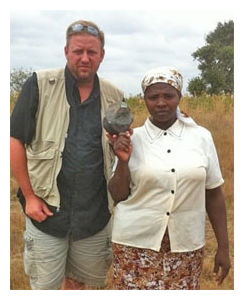
© Michael Farmer
Meteorite hunter Michael Farmer poses with Rose Kamande, who found this 7.7-pound (3.5-kg) stone on July 17, 2011 — one day after meteorites fell from the sky in the villages surrounding Thika, Kenya.
Meteorite hunter Michael Farmer poses with Rose Kamande, who found this 7.7-pound (3.5-kg) stone on July 17, 2011 — one day after meteorites fell from the sky in the villages surrounding Thika, Kenya.
Statistically, every year roughly 1,400 meteorites of pebble size and larger fall somewhere on Earth's lands. But few of these are ever found - and even fewer (about 3%) are actually seen as they arrive. Because they're rare, these witnessed falls are especially prized both by scientists (because the stones are fresh and unweathered) and by meteorite collectors (they command higher prices).
As it happens, a bunch of meteorites fell from the sky over east-central Africa on July 16th, and only now are details of this extraterrestrial special delivery coming to light.
On that morning, residents in villages near Thika, Kenya, heard a loud explosion but didn't know what to make of the strange stones that fell around them. Local police were called to investigate a sizable one that dropped into a cornfield and carted it off for further study.
This is a desperately poor region, and it didn't take long for local villagers to realize that these plain-looking rocks might be worth something. Word of the event soon reached meteorite hunters, and within hours the chase was on.
Michael Farmer wasted no time traveling from his Tucson home to Kenya. By the morning of July 21st, just five days after the fall, he'd acquired more than 2 pounds of fragments. By then hundreds of locals had fanned out in the hope of finding some cosmic gold.
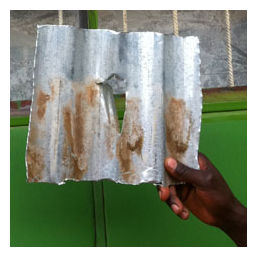
© Michael Farmer
A 70-g "hammer" meteorite punched through the corrugated-metal roof of a housing complex in the village of Muguga, Kenya, on July 16, 2011.
"Upon arriving at the fall location," he reports, "I met a guy who knew a girl who saw a stone land only 5 feet from her in a coffee field while working at 10:30 a.m. when the explosions rocked the sky." Farmer returned to Kenya again just a week later, this time accompanied by Florda dealer Greg Hupé.
All told, meteorites fell in four different villages. The fall will likely be known officially as Kihum Wiri, the place where the largest pieces were found. An analysis by researcher Laurence Garvie at Arizona State University indicates that these are ordinary chondrites, the most common meteorite type.
So far, more than 30 pounds (14 kg) have been scooped up. "I paid either for stones or for workers and supervisors to monitor the workers, money none of them could refuse," Farmer explains. "Most of them got a year or years of salary for stones worthless to them. It changed their lives."
A 70-g "hammer" meteorite punched through the corrugated-metal roof of a housing complex in the village of Muguga, Kenya, on July 16, 2011.
"Upon arriving at the fall location," he reports, "I met a guy who knew a girl who saw a stone land only 5 feet from her in a coffee field while working at 10:30 a.m. when the explosions rocked the sky." Farmer returned to Kenya again just a week later, this time accompanied by Florda dealer Greg Hupé.
All told, meteorites fell in four different villages. The fall will likely be known officially as Kihum Wiri, the place where the largest pieces were found. An analysis by researcher Laurence Garvie at Arizona State University indicates that these are ordinary chondrites, the most common meteorite type.
So far, more than 30 pounds (14 kg) have been scooped up. "I paid either for stones or for workers and supervisors to monitor the workers, money none of them could refuse," Farmer explains. "Most of them got a year or years of salary for stones worthless to them. It changed their lives."
MBIQ (Meteor Bot Internet Query) Indicates NE Colorado Meteor Event 2SEP2011
Colorado, east of Greeley and Northeast of Kersey: Bright Blue/Green Meteor Fireball seen at 4:00 am, 2 September 2011
My friend and I were at work out at 70 Ranch located at CR 388 and CR 53 Around 4 O'clock AM...9/2/2011. I saw a light that looked like a shooting star. It was bright out of the North and then it shot like a star to the East and then stopped for a few seconds. Then it came down from the north going south and then about a half mile to a mile off the ground it turned a dark to bright green a couple hundred feet around it and then it was traveling towards the ground with a Long tail burning. Looked green and blue. Then it came down and got really low to the ground before It looked like it was going to hit. It may have burnt out but don't know. Just thought it was awesome so I looked it up on the
news and no one reported it. My other friend was on the phone about 30miles south of me when I saw it, and he saw it to and asked me if I saw it too. Just thought it was cool so went to this website when I looked up meteors and it said I could report it here if I saw anything.
So I figured I would see what you guys knew. Thanks - Mark Merriott
Thank you Mark for your fine report!
Fort Collins, Colorado - arrived from google.com on "Latest Worldwide Meteor/Meteorite News" by searching for green fireball 9/2/11.
We need your sighting reports for this event:
Date and Time of event? Location name (town,city) where you were when saw the meteor? Start and Stop location in sky? Direction of movement? Duration of Event (seconds)? Brightness ( in comparison with Venus, Moon, Sun) color, sounds? Photos? Videos? please email LunarMeteoriteHunter@gmail.com Your reports make it possible for all to check what they saw as well. Thank you!
Did you see a fireball in the eastern sky Thursday evening? You're not the only one.
Emergency dispatchers in New Hanover and Brunswick counties received multiple reports of a blazing object in the sky at about 8 p.m.
Most likely, it was a meteor or comet fragment that made it into the atmosphere, said Tim Armstrong of the National Weather Service's office in Wilmington. There has been no confirmation of that, however.
And confirmation is unlikely. Armstrong said the object appeared to be over the ocean, making examination of it impossible.
Did you snap a picture? Email it in to Andrew.Dunn@StarNewsOnline.com.
Meteorites Contain Chemical Essential for Life
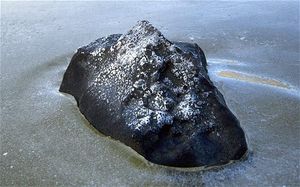
© Photo: REX
Fragments of a 10-tonne meteorite are found in a small pond Saskatchewan, Canada, 28 Nov 2008
Fragments of a 10-tonne meteorite are found in a small pond Saskatchewan, Canada, 28 Nov 2008
A chemical essential for life may have been brought to Earth from outer space by meteorites, scientists claim.
Astrobiologist Dr Terry Kee, from the University of Leeds, has found meteorite fragments contain a precursor to a key chemical that allows biological cells to capture energy from their surroundings.
He believes debris from meteorites that hit the Earth billions of years ago may have combined with slightly acidic water on the planet to produce early forms of the compound.
This would then have allowed the first forms of cellular life to form and to use energy from their surroundings.
"There is strong scientific evidence that chemicals essential to life have been found in interstellar material such as meteorites," Dr Kee said.
"Meteorites are fragments of some of the oldest materials in our solar system, and their composition can hold clues as to the appearance and environment of our own planet and what lived on it billions of years ago."
Dr Kee will present his findings to the British Science Festival on Wednesday 14th September as part of the Astrobiology: Life in Other Worlds event.
He and his research team found that when iron-based meteorites were dissolved in slightly acidic water, compounds called phosphates were formed.
After being subjected to heat of around 80 degrees, the phosphate compounds covert to pyrophosphate, which Dr Kee believes is a precursor of adenosine triphosphate (ATP), a molecule essential for respiration in cellular life forms.
ATP allows all living cells to convert the chemical energy stored in sugar so it can be used to drive processes in the cell.
Dr Kee says the high reactivity of pyrophosphate suggests that it fostered early chemical reactions in the acidic, warm pools that surrounded volcanoes.
He said:
"The application of acidic water and heat to the meteorites mimics the conditions of ancient planet earth's surface.
"If corroded by acid rain, the chemical pyrophosphate would be released from the meteorite into the earth itself. This may suggest the origins of chemical cycles and cell formation on the early earth."
Dr Kee is distancing himself from claims from NASA scientist Richard Hoover, who has claimed to have discovered extraterrestrial microfossils in a collection of meteorites three times in the last 14 years.
He said:
"We're not attempting to prove the existence of extraterrestrial life forms as such; we are concentrating upon the origins of earth's chemical processes, and why they evolved into life forms as they did.
"We believe that life did not evolve independently.
"There is a very good chance that extraterrestrial materials provided the building blocks of life on earth."
A comet is diving into the sun today. Just discovered by comet hunters Michal Kusiak of Poland and Sergei Schmalz of Germany, the icy visitor from the outer solar system is expected to brighten to first
magnitude before it disintegrates on Sept. 14th.
The Solar and Heliospheric Observatory is monitoring the comet's death plunge: finder chart, movie, latest images.
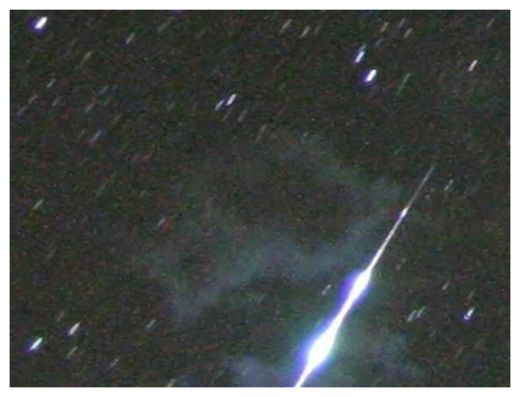
© Brian Emfinger
Brian Emfinger photographed this early Perseid meteor shower fireball, with a smoke trail, from Ozark, Arkansas just after midnight on Sunday, July 26, 2009.
Brian Emfinger photographed this early Perseid meteor shower fireball, with a smoke trail, from Ozark, Arkansas just after midnight on Sunday, July 26, 2009.
Mysterious booming sounds are occasionally heard on the North Carolina coast, often powerful enough to rattle windows and doors. They cannot be explained by thunderstorms or any manmade sources - their source is a mystery.
Such dins are not unique to North Carolina or the modern age. People living near Seneca Lake in upstate New York have long known of similar booming sounds, which they called "Seneca guns." In coastal Belgium, they are known as "mistpouffers," or fog belches; in the Ganges delta and the Bay of Bengal, "Bansal guns;" in the Italian Apennines, "brontidi," or thunder-like; and by the Harami people of Shikoku, Japan, "yan."
"What's going on is an interesting challenge, whatever it might be," said seismologist David Hill, scientist emeritus at the U.S. Geological Survey office in Menlo Park, Calif.
Long list of explanations
A host of plausible explanations may now exist for these enigmas, including earthquakes, rock bursts, mud volcanoes, explosive venting of gas, storm-driven waves, tsunamis, meteors, distant thunder and so-called booming sands.
"It seems there is quite a range of processes in nature that might be responsible," Hill told OurAmazingPlanet.
"Earwitnesses" described sounds like booming cannons or falling stones accompanying small to moderate earthquakes in England from 1880 to 1916. In 1975, U.S. Geological Survey researchers managed to record both acoustic and seismic signals of an earthquake swarm in California, finding that three earthquakes with magnitudes ranging from 2.0 to 2.8 produced sounds that began within 0.02 seconds of the arrival of seismic waves at the scientists' station. Similar results were seen with quakes in the French Pyrenees in 2004.
All in all, audible sounds from earthquakes might be perceived even when shaking is not, Hill suggested. For instance, while earthquakes are rare in coastal North Carolina, they are relatively common in the Charleston area of South Carolina, the site of the 1886 magnitude 7.6 Charleston quake, and the Catskill Mountains that Seneca Lake is located within do host low-level earthquake
activity. Locals could be hearing an earthquake that is too small for them to feel.
Also, rock bursts, where long-buried rock can suddenly release stress, often because of mining removing confining material above it, can essentially be seen as a type of small, near-surface earthquake. Scientists have reported feeling perceptible jolts and hearing sharp booming sounds from such bursts, Hill said.
Giant waves might also be responsible for the mystery sounds, Hill suggested. Scientists have found that booming sounds are apparently familiar to big-wave surfers during extreme waves. In addition, after the catastrophic 2004 magnitude 9.1 Sumatra earthquake and tsunami, multiple witnesses said they heard loud, offshore booming sounds closely accompanying two or three of the largest waves that struck the coast at any given site.
"I was surprised to learn about the possibility that tsunamis produce these kinds of sounds," Hill said. "I don't think anyone understands that process."
Hill suggests the sounds heard off the coasts of North Carolina, Belgium and the Bay of Bengal might be large waves caused by distant storms that break well offshore, beyond outer banks or barrier beaches. Such waves might also disrupt offshore methane hydrate deposits, leading to explosive venting of high-pressure gas trapped deep within the Earth.
Booming sands and seismometers
Another possibility is meteors. Meteors can generate sonic booms and explode dramatically as they plummet from space. Given how long it can take a shockwave to reach the Earth's surface from the upper atmosphere, visible signs of the meteor can vanish before its sonic boom is heard, especially during the daytime, Hill noted.
Under the right circumstances, even sand dunes can generate a variety of sounds, including whispering, humming, whistling and squeaking. Booming sands, comparable to rumbling thunder, can be heard to distances of 6 miles (10 kilometers) and for as long as 15 minutes, are possible as well. They generally appear limited to large sand dunes in arid climates with steep faces pointing away from the wind, and seem to require loosely packed, very smooth, almost spherical sand grains.
"In the eastern desert in Egypt, the Bedouins have a long history of hearing booms and avoiding that area - after installing seismometers there, researchers were able to go back and see these sounds seem
correlated with small earthquakes that caused booming sands," Hill said.
In the future, after potential artificial sources of mysterious booming sounds are ruled out, such as military exercises and quarry blasts, seismic networks could quickly reveal if earthquakes or volcanoes were responsible. For instance, the USArray, a mobile network of seismometers, is currently moving east across the United States and "it might help resolve the issue of what the sounds on the North Carolina coast are," Hill said.
Hill detailed this research in the September-October issue of the journal Seismological Research Letters.
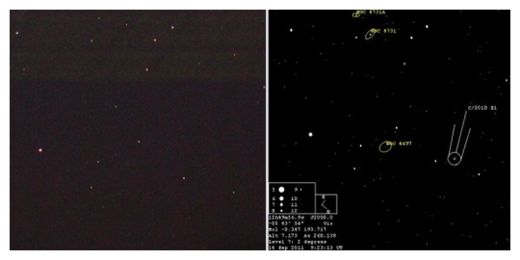
© Michael Mattiazzo
Comet Elenin on Sept. 14, 2011. It is is now almost indiscernible. Image and annotated chart by Michael Mattiazzo.
Comet Elenin on Sept. 14, 2011. It is is now almost indiscernible. Image and annotated chart by Michael Mattiazzo.
As far as Comet Elenin goes, the only chance of impending doom is for the comet itself: it is disintegrating and quickly fading away. Australian amateur astronomer Michael Mattiazzo has been monitoring this comet's trip toward perihelion (closest point in its orbit to the Sun), which occurred on September 10, 2011, and he says Comet Elenin has likely has not survived. The image above was taken by Mattiazzo on today (Sept. 14) and it is barely visible as a disintegrating smudge.
Comet Elenin - the comet that has created a hoopla of completely nonsensical, non-scientific doomsday predictions - faded dramatically after being hit by a solar flare on August 20, as we reported earlier. Subsequent images revealed a spreading, diffuse coma. It will likely continue to fade and become more diffuse.
Elenin's mass is smaller than average and its trajectory will take it no closer than 34 million km (21 million miles) of Earth as it circles the Sun. It will make its closest approach to Earth on October 16th, but was closest to the Sun on Sept. 10.
"On the night of August 19th, I estimated the brightness of comet Elenin as magnitude 8.1 and it was on target for naked eye observability in September," Mattiazzo wrote on his website, Southern Comets. "On the following night of the 20th, the comet had faded dramatically by half a magnitude and appeared more diffuse. This was a sign of impending doom for comet Elenin."
Elenin is at about magnitude 10 now, and fading as it is in the process of disintegrating.
It failed to recover, (you can see a series of images taken between August 19 and September 11 on Mattiazzo's website), with the comet's the nucleus taking on an elongated appearance with progressive fading.
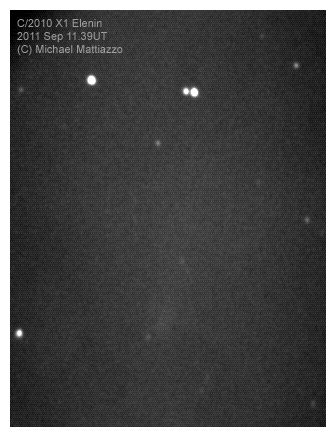
© Michael Mattiazzo
Comet Elenin on Sept. 11, 2011. 20x10second exposures taken with a C11 SCT and Starlight Express MX7c CCD imager.
Comet Elenin on Sept. 11, 2011. 20x10second exposures taken with a C11 SCT and Starlight Express MX7c CCD imager.
"Such acts of disruption are all too common for small comets that have close encounters with the Sun," Mattiazzo said.
One of the most spectacular examples of a comet breaking apart occurred in July 2000 when comet C/1999 S4 LINEAR disintegrated and several observatories had a good view of the action.
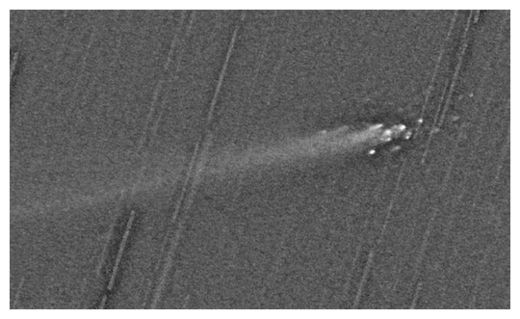
© ESO
A closeup photo of the breakup of Comet S4 LINEAR taken on August 6, 2000 by the European Very Large Telescope (VLT) in Chile.
A closeup photo of the breakup of Comet S4 LINEAR taken on August 6, 2000 by the European Very Large Telescope (VLT) in Chile.
Elenin is now nearly in solar conjuction, where it is on the opposite side of the Sun from the Earth and not visible to us. Another amateur astronomer from Australia, Ian Musgrave, says it is doubtful that it will be bright enough to see in the the cameras from the Sun-orbiting SOHO spacecraft, and that we will probably have to wait until October when the comet moves away from the Sun for powerful Earth-based telescopes to try and find if any of the comet survives.
Some Coachella Valley residents spotted something that looked to be falling from the sky tonight, amid reports of a meteor in the Southwest.
It looked like a falling star that continued falling toward the mountain, a Desert Sun reporter in south Palm Springs said.
The Scottsdale Airport tower told police they saw meteor activity around 7:45 p.m., the Arizona Republic reported.
Twitter users from Las Vegas to San Diego have also reported spotting the unusual activity in the sky.
"Okay did anybody else see the giant #meteor or #UFO that fell out of the sky 15 minutes ago?" @FRUTRON Tweeted.
The National Weather Service said it had not heard of any meteor activity, the Gannett-owned Phoenix paper added.
Palm Springs police said they have not received any calls about the object.
Reports stream in from Southern California and Nevada; experts say it's a meteor
People from San Diego to Los Angeles to Las Vegas reported seeing a large, greenish, fiery object shooting across the sky Wednesday night.
"I saw something that looked like a falling star but it must have been a fireball in the atmosphere," one witness told NBCLA. "It was huge. It had a green glow in front of it and a white tail. It like green
fireworks going across the sky."
Witnesses said they saw the fireball around 7:45 p.m. PT (10:45 p.m. ET).
The Federal Aviation Administration said they received many calls about the sky sightings. Initially, there were concerns that the fireball could have been an aircraft. But a spokesman from the National Weather Service told NBCLA that it sounded as if it was a meteor.
Experts said that a meteor is slower than a regular shooting star, and it's not unusual for it to appear to change colors.
In a Twitter update, scientists at NASA's Jet Propulsion Laboratory in Pasadena, Calif., said that "a lot of lucky people ... saw a fireball tonight" - and pointed to a webpage listing frequently asked questions about fireballs. The report said sightings were made in Arizona as well as California and Nevada.
A bright light across the sky was seen from Las Vegas, Phoenix, and Southern California on Wednesday evening.
Sources believe it was a meteor that came through the atmosphere, however it has not yet been confirmed.
Just after 7:45 p.m. TheWeatherSpace.com tip line was loaded with message of the sighting. Some describe it as a sight they've never seen before.
"I was sitting outside looking at the thunderstorms in the distance and the object caught my eye," said Janet Patton of Palm Springs, California. "It was easily brighter than the full moon and it cast
shadows.
Whatever it was, it caused a stir.
Many residents around Arizona have reported seeing a "glowing object" fly across the night sky Wednesday.
Some experts believe it was either a fireball or a bright meteor. We started getting reports of the object around 7:45 p.m.
Our multimedia journalist Brien McElhatten captured two photos when he saw a glowing orange light before an object started streaking across the sky.
One photo shows how the glowing light looked in Chandler. The other image was taken as McElhatten kept the shutter open to show the object streaking across the sky.
"It had a big old tail, and it was so bright. I couldn't believe what I was witnessing," Valley resident Holly Pickard told ABC15.
Law enforcement in the Valley also saw the object.
"We received four calls (total) regarding the light in the sky," a Phoenix Police spokesman told ABC15. "Our air unit, myself, and other officers also observed it as well. We all made our wishes and went back to work."
A spokesman with the Maricopa County Sheriff's Office said their aviation unit did confirm seeing the meteor over Deer Valley Airport, but there haven't been any reports of an impact site.
Many of our viewers are also sounding off about it on the ABC15 Facebook page.
Sharon Roesch wrote, "It was huge and incredible- we were driving and too much in shock."
Althea Keegan wrote, "It had a green tail and burned out just as I had my camera ready to snap a picture."
The ABC15 newsroom confirmed that there have been similar reports in San Diego, Los Angeles, and Las Vegas.
US: Mysterious light seen in Southwestern sky
What exactly was seen in the skies across the Southwestern U.S. Wednesday night? Was it a meteor, a falling satellite or, perhaps, something more mysterious?
A streak of light that some are describing as a fireball, was seen shooting across the night sky and law enforcement and media from Phoenix to Los Angeles to Las Vegas were fielding calls of the reported sighting.
Lt. Justin Griffin of the Maricopa Sheriff Department in Arizona was trying to guess what the strange light was.
"Believe it was a meteorite traveling from north to south across Maricopa County," Griffin said. "The 911 call center received a flood of calls."
Griffin said there were no reports of impact or damage.
"People are, indeed, reporting they saw a light head from west to east across the sky. We got reports from CHP and the FAA about callers seeing the light. It is reasonable to say that it may be a meteor," Curt Kaplan, a meteorologist with the National Weather Service told CNN affiliate KCAL.
There are no reports of aircraft incidents across Southern California, said FAA spokesperson Ian Gregor.
The sighting quickly became a hot topic on a number of social media websites with most asking, "Did you see it? What was that?"
NASA officials announced this week the now-defunct Upper Atmosphere Research Satellite is expected to fall back to Earth in the coming weeks.
There was no word on whether what was seen Wednesday was that satellite.
Fireball sparks panic as it shoots across 250 miles of night sky above California
When a streak of fire blazed through the air above southern California, people could have been forgiven for thinking the Earth was under attack.
Thousands saw it from Phoenix in Arizona to Las Vegas and Los Angeles and local authorities were swamped with reports of ball of flame in the night sky.
One witness said: 'It was huge. It had a green glow in front of it and a white tail. It looked like green fireworks going across the sky.'
But experts have revealed the phenomenon was most likely a fireball - a fragment of an asteroid that entered Earth's atmosphere.
The light was seen shooting quickly from west to east at around 7.45pm PDT, or 2.45am GMT.
Many reported it as bluish-green and others as yellow and orange. Some captured video of the object.
NASA scientist Don Yeomans, who runs the agency's Near-Earth Object Program, said: 'We can't say 100 per cent, but it's almost certain that the object was a fireball or very bright meteor the size of a basketball or baseball that likely disintegrated before it hit the ground.'
According to Mr Yeomans, the bluish-green colour suggests the object had some magnesium or nickel in it.
He added that orange is usually an indication it is entering earth's atmosphere at several miles per second, a moderate rate of speed.
'They make an impressive show for such a small object,' Mr Yeomans said.
Yeomans said fireball events are much more rare than shooting stars, but they happen on a weekly basis somewhere on Earth, usually over the ocean.
'It's a natural phenomenon and nothing to be concerned about.'
Astronomer Dennis Mammana, from Borrego Springs, said: 'Apparently this one put on a big show.
'The color of the object can tell you about the chemical composition of the meteor. The bluish-green color could mean it was nickel.'
At Maricopa County Sheriff's Office police fielded more than a dozen calls about sightings.
Sheriff's deputies at Deer Valley Airport in north Phoenix reported a sighting themselves, Lieutenant Justin Griffin said.
'It took an unusually long time to get across the sky,' Lt Griffin said. 'It's like a meteor. It's not like we had any flying objects with little green men or anything like that.'
Sergeant Steve Martos, of the Phoenix Police Department, said his agency received four calls 'regarding the light in the sky'.
He added: 'Myself and other officers observed it as well. We all made our wishes and went back to work. Nothing more to report. Have a safe night.'
The burning object also created a stir on Twitter.
One witness tweeted: 'I saw a lot of red in it from my vantage point in Phoenix, as well as the blue and green tail.
Another tweeted: 'It was crazy! Green and going fast & then it just burned out.'
Federal Aviation Administration spokesman Ian Gregor has confirmed there were no aircraft incidents reported in the Western region.
Dino-Killing Cosmic Impact Wiped Out Ancient Birds, Too
Charles Q. Choi
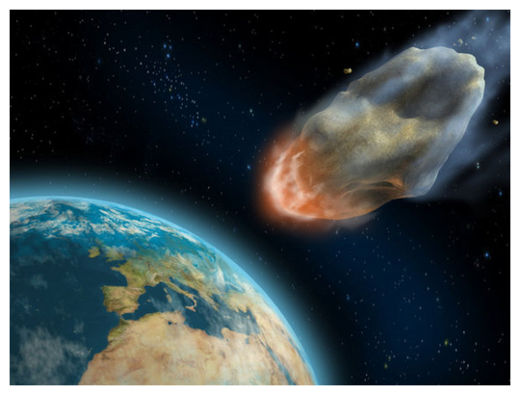
© Andrea Danti | Shutterstock
A cosmic impact at the end of the Cretaceous that wiped out non-avian dinosaurs seems to have decimated primitive birds as well, researchers now say.
A cosmic impact at the end of the Cretaceous that wiped out non-avian dinosaurs seems to have decimated primitive birds as well, researchers now say.
Although birds survived the mass extinction that claimed their brethren, the rest of the dinosaurs, birds did not emerge unscathed, scientists now find.
Apparently many ancient lineages of birds died off at the end of the Age of Dinosaurs, researchers added.
Nearly all the modern bird groups, from owls to penguins and so on, began to emerge within 15 million years after the rest of the dinosaurs went extinct. These birds are subtly but significantly different from many of the ancient lineages that existed before a cosmic impact at the end of the Cretaceous period about 65 million years ago wreaked havoc around the globe.
"These archaic birds superficially looked very similar to modern birds, but underneath their feathers they were completely different," researcher Nicholas Longrich, a vertebrate paleontologist at Yale University, told LiveScience. "Some of them had teeth. Some of their joints were built backward compared to modern birds, so they may have flown in a different way."
Although scientists had suspected that many ancient bird lineages went extinct along with a host of other creatures at the end of the Cretaceous, "the fossil evidence was kind of vague," Longrich noted. This uncertainty left open the possibility that such birds actually began dying off gradually well before the mass extinction.
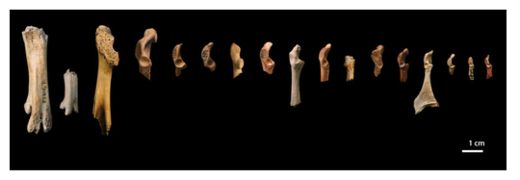
© Yale University
Two shoulder bones (far left) and foot bones from 17 species of Cretaceous birds that went extinct around the time of the dinosaurs.
Two shoulder bones (far left) and foot bones from 17 species of Cretaceous birds that went extinct around the time of the dinosaurs.
To help clear up this mystery, Longrich and his colleagues investigated ancient bird fossils from a variety of museums in the United States and Canada. They focused on specimens they had relatively certain dates for, ones from rock formations in states of Montana, North Dakota, South Dakota and Wyoming and the province of Saskatchewan in Canada.
The researchers identified seven species of archaic birds, including diving birds such as Hesperornithes, all of which lived within 1.5 million years of the asteroid impact, and most of which lived within 300,000 years before the impact. None survived past the end of the Age of Dinosaurs.
"It looks like their extinction was abrupt," Longrich said. "It looks as if the asteroid hit all the dinosaurs - not just the non-avian ones like T. rex and Triceratops, but the birds as well, the flying dinosaurs."
It remains unknown whether all the ancient birds that died out had anything in common that helped ensure their demise or what qualities the lineages that survived had that helped them endure.
"We only have scraps of all these early birds, so we don't really know what the handful of birds that survived ate, or where they lived, factors that presumably helped them survive," Longrich said. "It's a big unsolved mystery." Future research might look at ancient bird fossils elsewhere in the world to help solve the puzzle, he added.
The scientists detailed their findings online Sept. 13 in the Proceedings of the National Academy of Sciences.
US: Fireball seen over Western Oregon
A fireball streaked across the Oregon sky Wednesday evening.
Described as blue or green with a small tail, the object appeared shortly after 8 p.m. Reports of the sighting ran from Portland to Southern Oregon but seemed to be focused on the Central Willamette
Valley and Central Oregon Coast.
Candace wrote on the KGW TV Facebook page that "my daughter and I saw it. We were driving from Canby to Aurora and were near the intersection of 99E and Barlow Rd. I hit the brakes because it looked like it was going to land in the road in front of the car, but disappeared off to the side of the road. It looked like one steak from a light green firework coming down from the sky."
"We were traveling on Stayton-Scio hwy looking toward Mary's Peak in the Coast Range when we saw the meteorite burn from approximately 80 degrees to 30 degrees on the horizon where it broke
apart into a couple chunks and disappeared at about 30 degrees on the horizon," wrote poster Doug on the "Latest Worldwide Meteor/Metorite News" web site.
Poster Tabitha wrote "I am a wild land firefighter and that object appeared to be the color of a very hot flame. Like when ink on paper or cardboard burns, that real pretty blue flame was the color of the object falling."
More: lunarmeteorhunters.blogspot.com
Meteor Caught on Video by Troy Stone
One of our valued readers here in Universe Today sent us a link to a video that was first featured in a local news channel in Florida. It was a video of a bright green fireball shooting across the sky in Orlando, Florida. The video was recorded by Troy Stone using a dash cam as he was on his way to work in the morning of September 5, 2011.
According to the locals who were able to post the sighting online, the meteor was heading east to west when looking south.
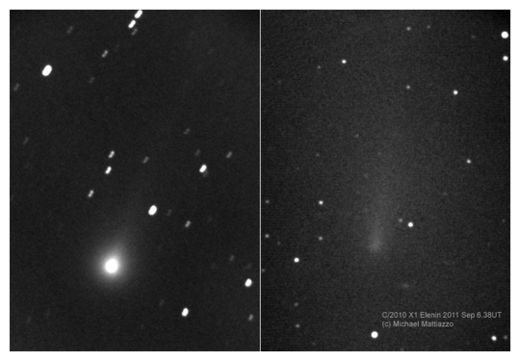
© Michael Mattiazzo
Amateur astronomer Michael Mattiazzo of Castlemaine, Australia caught these two images of comet Elenin on Aug. 19 (left) and Sept. 6, 2011. The images show a rapid dimming in the comet, possibly hinting at its disintegration.
Amateur astronomer Michael Mattiazzo of Castlemaine, Australia caught these two images of comet Elenin on Aug. 19 (left) and Sept. 6, 2011. The images show a rapid dimming in the comet, possibly hinting at its disintegration.
Russian amateur astronomer Leonid Elenin had the good fortune to discover a comet on Dec. 10, 2010, and it's turned out to be quite a skywatching curiosity.
Initially, comet Elenin received quite a bit of attention from astronomers because its orbit would take it quite close to Earth, within 22 million miles (35 million kilometers), on Oct. 16, 2011. It looked like it was going to put on a good show.
Even as recently as Aug. 19, the comet was brighter than predicted, as observed and photographed by amateur astronomers in Australia, notably Michael Mattiazzo.
Then, disaster struck in the form of a coronal mass ejection from the sun. The next day the comet had dropped half a magnitude in brightness, and has continued to drop, despite the icy body getting closer to the sun. Apparently the comet is disintegrating, as sometimes happens when comets pass too close to the sun.
Meanwhile, this rather small and ordinary comet has become the subject of media frenzy among conspiracy theorists and 2012 doomsayers. Comet Elenin has been accused of being a brown dwarf or the mysterious and destructive planet "Nibiru," and has been blamed for earthquakes and tsunamis. Did you know that its discoverer's name is really an acronym for "Extinction Level Event: Nibiru Is Nigh."
On Sept. 10 the comet passed its perihelion, a phase marking its closest approach to the sun, at a distance of 44,840,000 miles (72,170,000 km).
The next day, Mattiazzo managed a couple of images in the evening twilight sky as the comet dropped too close to the sun to be followed any further. The comet was a faint ghost of its former self.
Since then, the comet has been lost to view because of its faintness and its proximity to the sun in the sky.
NASA will hold a news conference at 1 p.m. EDT on Thurs., Sept. 29, to reveal near-Earth asteroid findings and implications for future research. The briefing will take place in the NASA Headquarters James E. Webb Auditorium, located at 300 E St. SW in Washington.
NASA's Wide-field Infrared Survey Explorer (WISE) mission, launched in December 2009, captured millions of images of galaxies and objects in space. During the news conference, panelists will discuss results from an enhancement of WISE called Near-Earth Object WISE (NEOWISE) that
hunted for asteroids.
The panelists are:
- Lindley Johnson, NEO program executive, NASA Headquarters, Washington
- Amy Mainzer, NEOWISE principal investigator, NASA's Jet Propulsion Laboratory, Pasadena, Calif.
- Tim Spahr, director, Minor Planet Center, Smithsonian Astrophysical Observatory, Cambridge, Mass.
- Lucy McFadden, scientist, NASA's Goddard Space Flight Center, Greenbelt, Md.
Reporters unable to attend may ask questions from participating NASA centers or by telephone. To participate by phone, reporters must contact Dwayne Brown at 202-358-1726 or dwayne.c.brown@nasa.gov by 10 a.m. EDT on Sept. 29.
The event will air live on NASA Television and the agency's website. For NASA TV streaming video, downlink and scheduling information, visit here. The briefing also will be streamed live, with a chat available here. For more information about the mission, visit here.
If all had gone as planned, the comet would be moving into the field of view of one of the cameras on NASA's Solar and Heliospheric Observatory (SOHO) satellite on Friday (Sept. 23). If so, the big question is: what will SOHO see about this comet?
Most people look at the images from SOHO for the rich information they supply regarding the sun. However, the wide-field images also show the sun against the starry background on the far side of the solar system.
Careful comparison of the images in SOHO to the images in planetarium software allow you to identify the background stars, and watch the planets pass behind and in front of the sun.
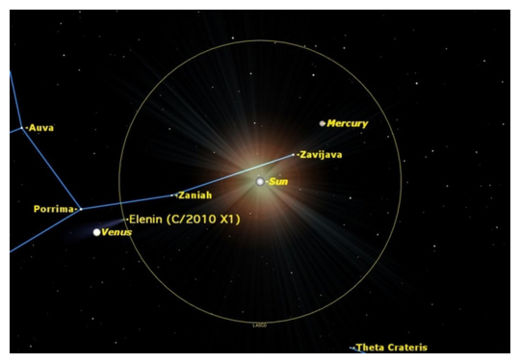
© Starry Night Software
Comet Elenin will be moving into SOHO’s field of view on Friday September 23. Or will it?
Comet Elenin will be moving into SOHO’s field of view on Friday September 23. Or will it?
This sky map of comet Elenin's path shows the situation on Friday, as the remains of the comet enter SOHO's field of view from the left. The bright stars Zaniah and Zavijava of western Virgo should be easy to see, but brilliant Mercury will dominate the images on the right.
Elenin will pass Zaniah on Sunday (Sept. 25) and Mercury on Tuesday (Sept. 27), before moving out of SOHO's field of view on Thursday (Sept. 29).
At this point, no one can predict exactly what we will see through SOHO's eyes in the coming week, but everyone will have the chance to watch using one of NASA's brightest eyes on the solar system.
If comet Elenin survives its close encounter with the sun, it will become visible in morning twilight towards the end of the first week of October.
US: Meteorite Hits California House
Sacramento - While many in the world are wondering where on Earth a falling satellite could hit, one California man had his own space mishap.
A meteorite slammed into his house!
"What happened?"
That was how Mike Gibson responded after he was rudely awakened the night of August 13.
"I heard a boom like you wouldn't believe hitting our house, middle of the night," said Gibson.
He ran outside and searched his roof with a flashlight, and that's when he saw what happened.
"A huge impact zone about 4 ½ -6 feet around was in my roof," he said.
But Gibson still didn't quite know what had happened.
The Perseid meteor shower was taking place, and Mike thought maybe, just maybe it was a meteorite that hit his home.
But he couldn't find proof.
That's when his son, Ben, joined in the search in the front yard plants.
"Grabbed some gloves, brought it over, started lifting it up, soon as he lifted it up, you're able to see, it's not a rock from Earth," he said. "We took it over to City College, my daughter did, to her astronomy professor and he tested it, and it has magnetism, that's a meteorite."
But with all the initial excitement came the harsh reality this meteorite did thousands of dollars in damage to the home, and could've done some serious harm.
"Going faster than a bullet, it's hitting at 20,000 miles an hour," he said.
Gibson is just happy that no one was injured, and now a month later, is still excited about his outer space visitor.
Argentina: One woman killed and six injured as meteorite smashes into Buenos Aires
Mystery explosion and Esteban Echeverría, "a ball of fire fell from heaven"
One woman died and six others were injured in the incident. A neighbor said the outbreak was caused by a burning object that fell from the sky and completely destroyed a house and several cars. "It was a tremor," he said. Are the causes of the accident.
The incident occurred minutes before 2 am, in a building located on the intersection of Luis Vernet and Los Andes, a town of Monte Grande, of Esteban Echeverría. The causes of the explosion are still unknown, but locals say they witnessed the fact that "a ball of fire fell from heaven." "He began to feel much smell like gunpowder," recalled one person who lives in the area told C5N. "There is no explanation for what happened," said Cayetano, a local resident, told Radio 10, then adding, "a neighbor ran because he saw a fireball falling blue." The commander of the local fire department, Guillermo Pérez, remarked that still do not know the cause of the incident, but acknowledged that the first version is aimed at an "object that fell from heaven." "I heard that version, but I can not say at first. Must be bound to expertise to really see what happened, "he said in a statement to Radio 10. Perez confirmed that two trade houses and" were completely destroyed. "In fact, a woman who was trapped under the rubble lost life while six others were rescued and were taken for care at a local hospital, told C5N firefighters who work on site.
The victim is one of the people who lived in the building where the explosion was generated. As the injured, three belong to that house and three adjoining the house, hit by the blast. All the injured were
out of danger, said C5N. According to the story of neighbors, the outbreak was felt even in adjoining towns like Ezeiza and Temperley, south of Buenos Aires.
US: Texas Residents Report Something Fell From Sky, Then Fire
San Leon - An object falling from the sky could be to blame for a Saturday grass fire.
"When the call came in to the dispatcher, the person said that something fell from the sky and started the fire," Jeff Pittman, chief of the San Leon Fire Department, said.
The chief said an investigation will be conducted to determine the cause of the blaze at 18th Street and Broadway.
"It could be awhile before we figure out what happened," he said. "It could be (today) because of the lighting."
The call came in at 5:36 p.m. Saturday and the fire was under control by 7 p.m.
Along with San Leon, firefighters from Texas City, Dickinson, League City and Kemah responded to the call.
Galveston County sheriff's deputies and Galveston Area Emergency Medical Services personnel also were on the scene.
Pittman said about 60 acres of grass and brush burned.
After the fire was out, firefighters conducted a grid patrol using metal detectors to determine if something did fall from the sky, according assistant fire chief Scott Lyons.
"There was no property damage," he said. "It was an unimproved field.There were no injuries, either, just a lot of tired firemen."
People all across the Gulf Coast reported seeing a large, perhaps green object streaking through the skies about 7:20 p.m. Sunday.
So far, there's no official word on exactly what the object was. NorthEscambia.com and other media outlets received sighting reports from around the area - Atmore, Walnut Hill, Cantonment, Mobile and
Pensacola. WKRG TV reports that their meteorologist Johnathan Owens saw the object, which he described on his Facebook page as likely a small piece of an asteroid or a large meteor - and obviously completely burned up in the atmosphere".
Did you see the object? Did you happen to get a picture? Email news@northescambia.com and let us know.
Footage from Japan shows falling object possibly UARS Satellite
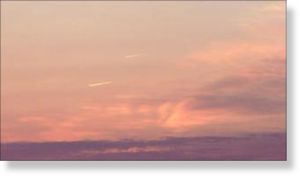
© Unknown
Another picture, taken by a Chatswood man, of the same ``UFO'' seen by Xavier Figarella last Sunday
Another picture, taken by a Chatswood man, of the same ``UFO'' seen by Xavier Figarella last Sunday
A second person has come forward with photographs of what some believe was a UFO travelling across the northern beaches skyline on Sunday morning.
A Chatswood man, who asked to remain anonymous, managed to capture an image of two of the mysterious objects seen by Dee Why man Xavier Figarella.
Mr Figarella claims to have seen the two objects but was only able to photograph one.
"We witnessed essentially the same phenomena ... but from a completely different angle and probably from much further away," the man said.
"I estimated the objects to be hovering over the northern beaches area."
But the man said he did not believe what he saw was a UFO.
"I rationalised the entire phenomena as a reflection of the sun light off the vapour trails left by multiple oncoming airliners," he said.
Airservices Australia has maintained that the objects photographed in both instances were not UFOs.
"These are condensation trails, or 'contrails', of high-altitude aircraft. Contrails can be long or short, hang around for seconds, minutes or hours and are particularly spectacular at sunrise and sunset."
Buenos Aires, Argentina - An explosion wrecked two homes, a business and several cars early Monday, killing a woman and injuring nine people on the outskirts of Argentina's capital.
Early reports by some witnesses that they had seen a ball of fire fall from the sky around the time of the 2 a.m. explosion caused a sensation, but authorities said later that evidence pointed to an explosion of leaking gas.
Officials said a search by the more than 100 police and others turned up a canister of natural gas with a poor connection to a pizza oven.
After the reports of a fireball coming down, the government dispatched the large number of searchers to check for radioactivity and any material that might have come from outer space. Provincial justice and security minister Ricardo Casal said experts were "evaluating all theories, from an explosion to something strange that came from the sky."
But the experts found no evidence of a crater, and NASA said its satellite that fell to Earth sometime Saturday landed well clear of South America.
Late in the day, the government said it appeared the blast was probably caused by a pizza oven's poorly connected gas canister.
A young man who had claimed he photographed a space object and gave authorities a picture showing a streak of red light through the night sky was detained for providing false testimony, the Argentine news agency Diarios y Noticias said. The man changed his story under questioning, the report said.
Comment: The purported photograph of the fireball, above, captured by a young man who was later forced to confess that it was a hoax, is probably based on the reasoning that the fireball in his photograph is red, while other witnesses described seeing the fireball emanating a blue light. What the authorities don't realise is that meteors burning through the Earth's atmosphere can go through 4, 5 or more colours of the rainbow before fizzling out or impacting the ground.
Notice how the media casually dismiss "earlier reports" with fabrications about gas canisters from a leaky pizza oven obliterating a suburban street.... even though Argentinian investigators have already ruled out a gas leak.
That ain't no satellite! Meteorite impacts Buenos Aires, Argentina
A woman died and eight people were injured in an overnight house explosion in Monte Grande, Buenos Aires province. According to police sources the cause of the violent explosion remains unknown. The blast occurred around 2 am at Los Andes and Vernet streets.
The wounded were taken Santamarina hospital. Seven people are being treated, one person has been cleared. The deceased woman was identified as 43-years-old Silvina Espinoza.
Neighbors' accounts describe a ball of fire coming from the sky as the cause of the explosion. The chief of the firefighters, Guillermo Pérez, however, said the "causes remain unknown" and that "gas containers were found intact," ruling out a gas related incident.
The blast caused destruction in several structures and cars surrounding the house.
Comment: Argentinian investigators name meteorite victim, rule out gas leak behind Buenos Aires explosion
Witness who photographed Buenos Aires meteor arrested for 'giving false testimony', police force him to change his story
That ain't no satellite! Meteorite impacts Buenos Aires, Argentina
US: Missouri - Loud "BOOM" Reported Across Laclede County
Fort Leonard Wood answered numerous calls today (9-27) about a loud boom that was heard around 9:30 throughout Laclede County. According to Jeff Maddy, PIO for the Fort, some people even reported hearing it in Greene County.
One woman who emailed KSPR News said "it knocked the dust off the rafters where i work. Thunder doesn't do that!"
Another person tells KSPR News the owner of the Willard Quarry outside Lebanon told him the sound was not the result of any blasting.
Fort Leonard Wood has a cannon range on the west side of the post. It's used often by the Missouri Air National Guard for bombing practice.
"They use no live ammunition," Maddy said. "Just sacks of flour and things like that to mark the drop." Maddy said some people suggested it was a sonic boom, the sound made by a plane that breaks the sound barrier.
Maddy said one caller told him Whiteman Air Force Base told them it wasn't any of their aircraft. Maddy is waiting to hear back from the Air National Guard in St. Louis.
A woman posted on the KSPR Facebook page that she and several others heard a loud boom in Bolivar Sunday evening.
NASA will reveal new findings about near-Earth asteroids during a press conference this Thursday (Sept. 29), agency officials announced today.
Scientists will present results based on data gathered by NASA's Wide-field Infrared Survey Explorer (WISE) spacecraft. The briefing will take place at 1 p.m. EDT (1700 GMT) Thursday at NASA headquarters in Washington, D.C., and it will have "implications for future research," NASA officials said in a media advisory.
From January 2010 to February 2011, WISE hunted for asteroids and comets in a mission called NEOWISE (with the NEO standing for "Near-Earth Object"). The observatory found more than 33,000 new space rocks in the main belt between Mars and Jupiter. [Photos From NASA's WISE Telescope]
Four panelists will discuss discoveries from the NEOWISE project, NASA officials said. Those panelists are:
- Lindley Johnson, NEO program executive, NASA Headquarters, Washington, D.C.
- Amy Mainzer, NEOWISE principal investigator, NASA's Jet Propulsion Laboratory, Pasadena, Calif.
- Tim Spahr, director, Minor Planet Center, Smithsonian Astrophysical Observatory, Cambridge, Mass.
- Lucy McFadden, scientist, NASA's Goddard Space Flight Center, Greenbelt, Md.
The $320 million WISE telescope launched in December 2009 and spent 14 months scanning the heavens in infrared light. It shut down in February 2011.

© NASA/JPL-Caltech/UCLA
This collage shows the 20 new comets discovered by NASA's NEOWISE mission, an extension of the WISE space telescope mission
This collage shows the 20 new comets discovered by NASA's NEOWISE mission, an extension of the WISE space telescope mission
NASA has a special interest in asteroids. In 2010, the Obama Administration directed the space agency to send astronauts to a space rock by 2025, as part of a plan to get people to Mars by the mid-2030s. And NASA recently announced that it will launch an $800 million asteroid sample-return mission called Osiris-Rex in 2016.
Osiris-Rex will rendezvous with a potentially dangerous asteroid called 1999 RQ36 in 2020, snag a few samples, and return them to Earth in 2023.
Since 1999 RQ36 is packed full of carbon-based compounds - the building blocks of life as we know it - the mission could shed light on how life originated on Earth. It could also help scientists better
understand how to prevent or mitigate asteroid impacts, researchers have said.
A stream of charged particles from a massive solar storm gave Earth only a glancing blow, but it was still strong enough to provide skywatchers from New Zealand to Norway with "unforgettable" displays of the aurora.
The coronal mass ejection arrived at about 5 million mph, triggering a geomagnetic storm high in Earth's atmosphere.
"These were some of the most amazing auroras I have ever seen," said photographer Fredrik Broms of Kvaløya, Norway.
He told Spaceweather.com: "The colors were absolutely stunning with purple and deep blood-red in addition to the green. It was a night I will never forget!"
Observers said the Northern Lights were so vivid across Scandinavia that they could even be seen through rain clouds.
The sunspot that created the stream of charged particles was large enough to be seen from Earth with the naked eye in the setting sun.
There were no reports of electronic or communications difficulties due to the geomagnetic storm.
Here We Go Again! Another Dead Satellite to Fall From Space in November
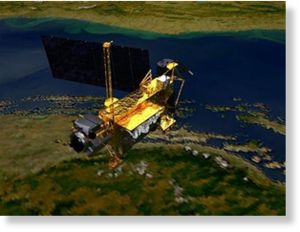
© Reuters/NASA
NASA conceptual image shows the Upper Atmosphere Research Satellite (UARS), launched on September 15, 1991, by the space shuttle Discovery.
NASA conceptual image shows the Upper Atmosphere Research Satellite (UARS), launched on September 15, 1991, by the space shuttle Discovery.
A defunct NASA satellite that fell to Earth last week sparked some worldwide buzz, but it's not the only spacecraft falling out of space.
The decommissioned German X-ray space observatory, called the Roentgen Satellite or ROSAT, will tumble to Earth sometime in early November, but it's still too early to pinpoint exactly when and where debris from the satellite will land, according to officials at the German Aerospace Center.
The 2.4-ton spacecraft's orbit extends from the latitudes of 53 degrees north and south, which means the satellite could fall anywhere over a huge swath of the planet - stretching from Canada to South America, German Aerospace officials said.
The latest estimates suggest that up to 30 large pieces of the satellite could survive the intense and scorching journey through Earth's atmosphere. In all, about 1.6 tons of the satellite components could reach the surface of the Earth, according to German Aerospace officials.
The re-entry will be similar to NASA's 6-ton Upper Atmosphere Research Satellite (UARS), which plunged into the southern Pacific Ocean on Saturday (Sept. 24).
ROSAT coming home
In 1998, ROSAT's star tracker failed, which caused its onboard camera to be pointed directly at the sun. The event permanently damaged the spacecraft and ROSAT was officially decommissioned in February 1999.
Scientists are actively tracking the dead satellite, but many of the details will remain uncertain until roughly two hours before it hits Earth.
"It is not possible to accurately predict ROSAT's re-entry," Heiner Klinkrad, head of the Space Debris Office at the European Space Agency, said in a webcast posted on the German Aerospace Center's website. "The uncertainty will decrease as the moment of re-entry approaches. It will not be possible to make any kind of reliable forecast about where the satellite will actually come down until about one or two hours before the fact."
It will, however, be possible to rule out certain geographical regions from the potential drop zone about a day in advance, Klinkrad said. The largest piece of debris is expected to be the telescope's heat resistant mirror.
"Generally speaking, whenever a satellite re-enters the atmosphere, about 20 to 40 percent of its mass actually reaches the Earth's surface," Klinkrad said. "In the case of ROSAT, this figure could be slightly higher because one of its characteristic features is that it carries heat-resistant mirror structures on board."
Small risk to public
Fragments from ROSAT could fall back to Earth over a 50-mile (80-kilometer) wide path, but despite the uncontrolled nature of ROSAT's re-entry, the odds of personal injury or property damage are extremely remote, German Aerospace officials said.
When NASA's UARS satellite fell to Earth, for example, NASA said the chances of parts of the spacecraft striking any one of the nearly seven billion people on the planet were about 1 in 3,200. The actual personal risk of being hit for an individual person, however, was about 1 in several trillion, NASA officials said.
To date, there have been no reported serious injuries or casualties from falling space debris, NASA scientists have said.
Comment: Another "Satellite?" Yeah right! More like another meteor!
Check out these links from the last so called "satellite crash".
Video: Aftermath of fireball which destroyed part of Buenos Aires - 1 dead, 8 injured
Argentinian investigators name meteorite victim, rule out gas leak behind Buenos Aires explosion
Witness who photographed Buenos Aires meteor arrested for 'giving false testimony', police force him to change his story
That ain't no satellite! Meteorite impacts Buenos Aires, Argentina
This morning a quartet of amateur comet hunters (M. Kusiak, S. Liwo, B. Zhou and Z. Xu) independently noticed a comet in SOHO coronagraph images. The icy visitor from the icy solar system is diving toward the sun--probably a one-way trip. Kusiak expects the doomed comet to brighten to first magnitude between now and the early hours of Oct. 1st.
Realtime images here.
A loud boom shook the coastal Lowcountry Wednesday morning, felt from Mount Pleasant to West Ashley. And once again, no one could say what it caused it.
Seismographs at the College of Charleston didn't pick up any earthquake activity. The Charleston Air Force Base didn't report any military aircraft creating sonic booms.
No commercial vessels responded to a U.S. Coast Guard message asking for reports if it had been felt offshore.
The reverberation most likely came from the "Seneca Guns," a so-far-unexplained phenomenon felt along coasts around the world.
Some experts speculate that the booms are caused by gases released from the sea floor, or undersea landslides along the Continental Shelf, or the echoed sound of distant thunder, or lightning-like electrical discharges, or even meteors crashing into the atmosphere at angles.
The latest blast hit just before 10 a.m.
"It was a pretty good shake, a pretty loud boom," said Mark Reamer, who felt it in the Financial Management
Group office off Coleman Boulevard near Patriots Point in Mount Pleasant.
"I said it was probably one of those big electricity pillars getting pummeled down." He wondered only half-facetiously if it might have been a piece of the satellite that fell out of orbit last week.
"The mirrors on the wall rattled," said Melinda Issacson, who was working out at home on James Island.
Doors, windows and houses shook in Mount Pleasant and on Sullivan's Island, according to Twitter reports. A West Ashley tweeter said it sounded like a gust of wind against the house.
About the same time, a large tree fell across Hut Road on Johns Island and a nearby resident reported an explosion. But a tweeter in North Charleston said nothing was felt there.
Small quakes and other booms are regular occurrences in the Lowcountry, where a series of faults converge underground. The last big shake was a temblor from the 5.8 Richter scale quake in Virginia in August.
In March, a succession of three loud booms shook the coast that were widely believed to be the Seneca Guns.
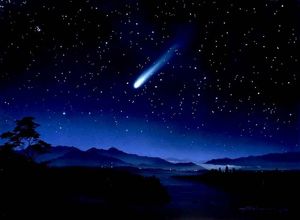
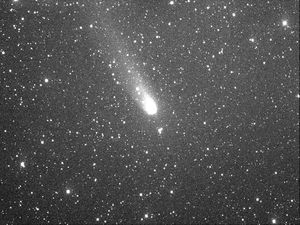
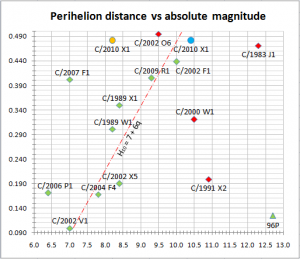

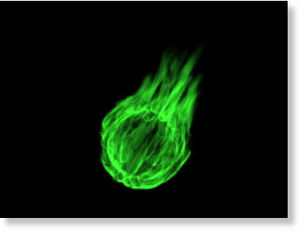
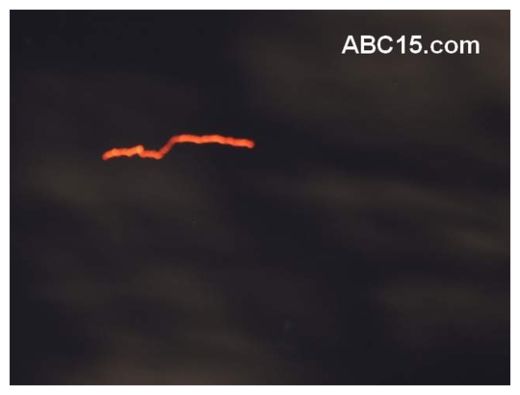
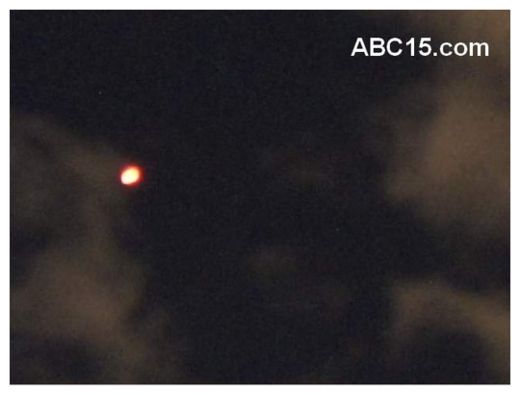

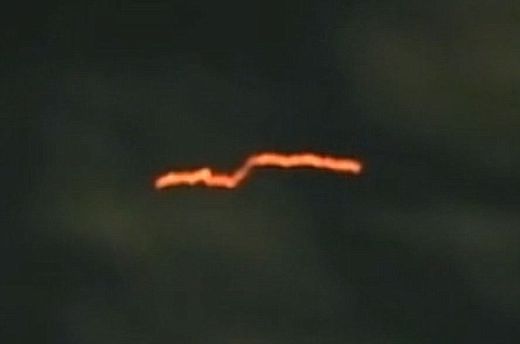
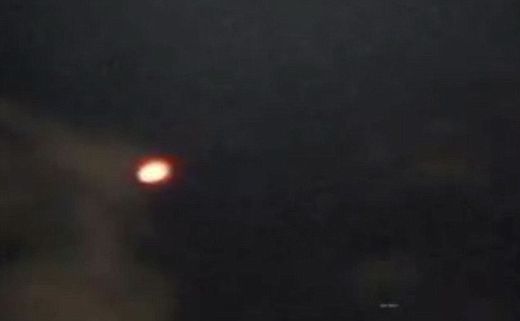
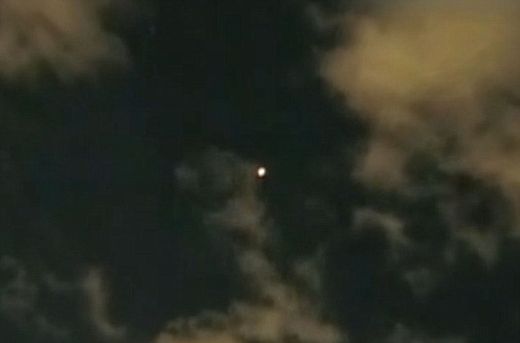
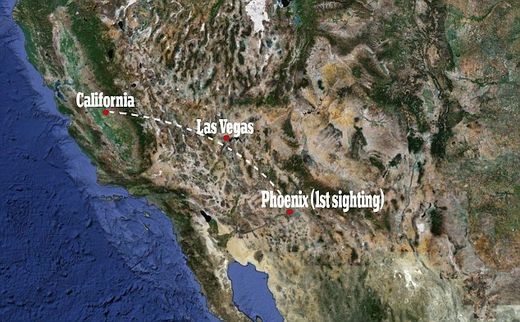
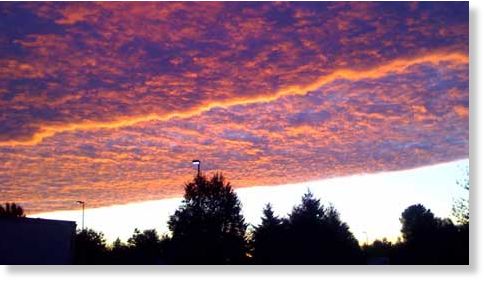

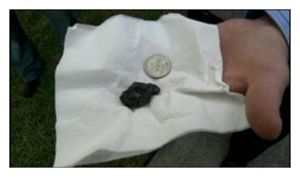
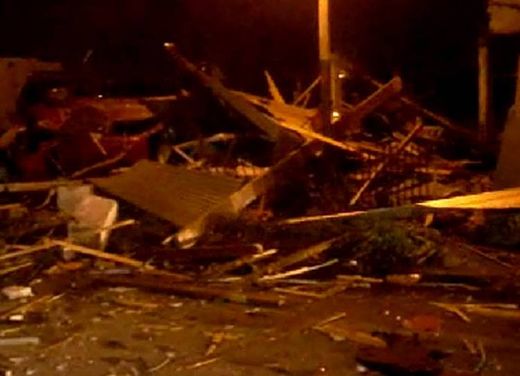
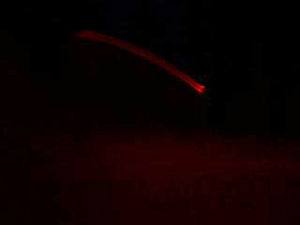
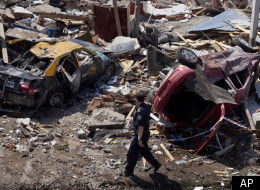

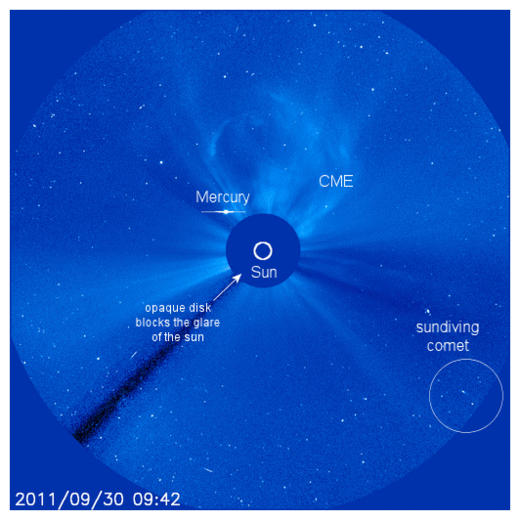

No comments:
Post a Comment